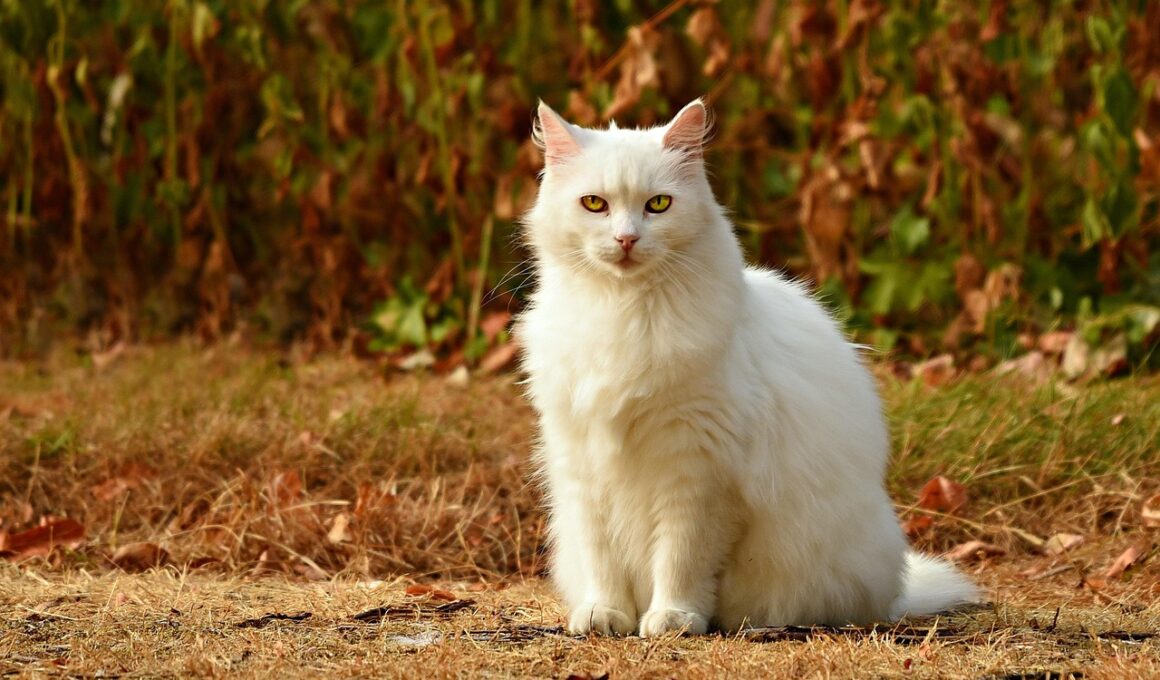Identifying Hazards in the Yard for Senior Cats
When it comes to senior cat care, evaluating outdoor safety is paramount. A safe environment contributes to their overall well-being, especially since aging cats are more susceptible to accidents and injuries. The yard can be filled with hidden hazards that are not initially apparent. First, consider the plants in your garden; certain plants can be toxic to cats. Popular houseplants like lilies or azaleas pose a risk. Always research any new additions you may make to your garden before planting. Another aspect to assess is the presence of chemicals. Pesticides and herbicides can linger in the soil long after application, creating a toxic environment. Moreover, check for sharp objects, such as metal scraps or glass shards, that can easily injure your senior cat. It’s also wise to evaluate fences or barriers for any gaps. Senior cats may be more prone to wandering off, so securing the perimeter is essential. Building a safe space by removing hazards helps ensure your cat can enjoy outdoor time without fear of injury. Regular monitoring and adjustments will ensure a safer outdoor experience for your elderly feline friend.
As you continue to establish a safe outdoor space, remember that the terrain must be suitable for your senior cat. Uneven surfaces, rocks, or any sort of debris could pose a tripping hazard. Senior cats may experience decreased mobility due to joint pain or other health concerns, making it crucial to provide them with an accessible area. Soft, cushioned surfaces can assist in preventing injuries. You may consider adding outdoor mats or soft grass patches to minimize any potential risks. Additionally, watch for the weather conditions before letting your cat out. Extreme heat can lead to heatstroke, while cold temperatures may cause discomfort and health issues. Always provide a shaded area or shelter where your cat can retreat during harsh weather. Furthermore, consider using collars with tags so your pet can be identified quickly if they wander off. Invest in a sturdy leash and harness system for additional security while outside. This not only keeps your cat physically within bounds but also provides peace of mind. A little preparation and proactive maintenance go a long way in promoting safety outdoors for your senior feline companions.
Common Poisonous Plants
Identifying common poisonous plants in your yard can protect your senior cat from harm. Several popular garden plants are toxic to cats and should be avoided at all costs. Classic examples include foxglove, oleander, and rhododendron. These plants can cause serious health issues if ingested, leading to vomiting, diarrhea, or even more severe symptoms. Before adding any plants, check their safety for pets. Utilize reliable resources such as the ASPCA’s toxic plant list or consult your veterinarian to ensure a safe environment. Additionally, keep in mind that ingestion isn’t the only danger; cats can be sensitive to walking among these plants. Chemical pesticides used to treat gardens can also endanger your cat’s health. Choose alternative pest control methods to keep your environment safe, like natural repellents or traps. Having a well-informed plan can significantly reduce the risk of your pet coming into contact with harmful substances. Regularly monitoring your yard for any new plant growth is also key to maintaining safety. By prioritizing your cat’s surroundings, you can prevent potential poisoning incidents that could lead to serious health issues or vet visits.
Another significant hazard to consider is wildlife in the area. Cats, especially seniors, may be less agile and may not react quickly enough to potential dangers, such as aggressive dogs or wild animals. Birds and smaller mammals can also be tempting prey for your feline, particularly those that may approach closely. Ensure that you are aware of the wildlife species in your area and how they might interact with your senior cat. If there are risks from larger animals, consider supervising your pet while outside, which will help in protecting them from unwanted encounters. Additionally, be aware of the presence of insects, specifically in warmer months. Bees, wasps, and spiders can pose a danger either through bites or stings; senior cats may be more vulnerable to these types of injuries. Keeping the yard free from unnecessary debris can deter unwanted pests and provide a safer space. Regular clean-ups are essential for maintaining a safe yard for your cat. By evaluating both larger and smaller wildlife threats, you can develop a well-rounded safety plan tailored to your senior feline’s needs.
Secure Perimeters
Securing the perimeter of your yard is an essential practice in ensuring the outdoor safety of senior cats. Cats are naturally curious creatures and may have the urge to explore beyond the confines of your property. Check for any openings in fences or gates that could provide an escape route. High areas of grass or shrubs can offer cover and motivate your cat to wander off. Repair any holes or gaps you discover, and consider using physical barriers or specialized cat fences to impede their movement. Certain solutions include mesh netting or wire fencing, which can help keep senior cats contained. It’s also important to keep the yard free from objects that might attract the cat’s attention, such as bird feeders or shiny items. Moreover, installing motion-sensor lights will deter both your cat and nighttime critters. These lighting installations add an extra layer of awareness for you when supervising outdoor playtime. Lastly, educate yourself on neighborhood wildlife and consider bringing your cat indoors during times when dangers from wildlife may peak, thereby further enhancing their safety during outdoor adventures.
In addition to creating a safe perimeter, ensuring that your cat has comfortable access points into the house is crucial. Senior cats often experience mobility challenges and may find it difficult to navigate high thresholds or steps. Use pet ramps or steps to aid them in safely entering and exiting the house. Moreover, a well-established transition area can help them familiarize themselves with outdoor changes. Incorporate comfy resting spots near the entrances. This not only encourages your cat to return indoors safely but can also serve as a quick retreat if they feel uncomfortable. Consider including soft bedding in these areas as well. Providing these accessible transition areas fosters a welcoming outdoor environment for your senior feline while reducing potential stress from trying to get back inside. Make sure to reinforce positive behavior by rewarding them for using the ramps. This reinforces their comfort and builds familiarity with the equipment. Keeping the transition as smooth as possible can ensure your senior cat’s outdoor experiences are both enjoyable and safe, enhancing their quality of life as they age.
Health Monitoring
Health monitoring is crucial for maintaining the safety and well-being of senior cats as they navigate the outdoors. Regular veterinary check-ups ensure any existing conditions are managed effectively and can help identify health concerns before they escalate. Senior cats may develop conditions such as arthritis, kidney disease or diabetes, which can influence their outdoor activities. Being attentive to weight loss or changes in behavior can signal potential problems. Keeping a close eye on your cat’s habits during outdoor time can inform you of changes that may require further assessment. Further, administering preventative care such as vaccinations can safeguard your cat against various infectious diseases. Also, consider investing in pet insurance if you haven’t already, as it can assist you with unexpected medical costs related to outdoor accidents. If your senior cat exhibits symptoms of distress or discomfort while outside, promptly bring them indoors and consult with your veterinarian. Keeping a detailed record of their outdoor activities, like time spent outside, can provide invaluable insight during vet visits. This comprehensive health monitoring approach ensures your cat remains happy, healthy, and safe while enjoying their yard adventures.
Ultimately, facilitating a safe outdoor environment for senior cats involves a multi-faceted approach. Preparation, constant evaluation, and proactive strategies can significantly enhance their outdoor experiences while keeping them secure. Regular maintenance checks, from assessing the perimeter for breaches to monitoring vegetation for toxic plants, are vital tasks. By implementing safety measures, such as secure entrances and health checks, you are creating a nurturing space that promotes their well-being. Additionally, aligning your outdoor space with comfort considerations ensures that your senior cat enjoys their time outside. Focusing on these essential strategies fosters an enriching outdoor atmosphere while minimizing risks. Encouraging field exploration in a controlled manner can bolster their mental health and vitality. Being observant and responsive to your cat’s needs will enable you to address any potential hazards quickly, ensuring they remain safe. With a dedicated mindset towards outdoor safety, each outing can transform into an enjoyable experience for your senior pet. Always seek to educate others about the unique needs of senior cats for better overall community awareness and care. By being proactive, you ensure that the golden years of your cat are filled with joy and vitality, creating lasting memories.


